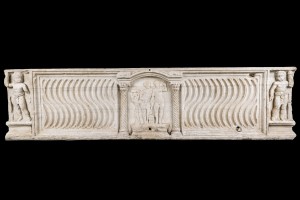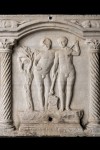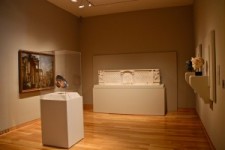
Unknown
Roman
Sarcophagus, 3rd c. CE, 2nd half
marble
20 ½ x 85 x 24 in.
SBMA, Museum purchase, Ludington Deaccessioning Fund
2009.1.2

Detail from side of Sarcophagus

Sarcophagus on view in Thayer Gallery.
COMMENTS
A sarcophagus is the ancient Roman equivalent of a modern day coffin. On occasion sarcophagi featured inscriptions on their lids (much like our tombstones do) that help scholars today understand who the sarcophagus was originally made for. The Roman sarcophagus from the late third century CE now on view in Thayer Gallery is covered on three sides with relief carvings but bears no inscriptions. Without the help of an inscription, what, if anything, can the images tell us about the person who was buried inside the sarcophagus?
This is a tough question, because sarcophagi were occasionally re-used, both in Antiquity, and in later periods. The original occupant would be displaced, and the sarcophagus reused for another burial.
Other times, more than one person was entombed in a single sarcophagus; men, women, and children together, making the most of what was a rather costly burial container. In other cases, sarcophagi were used to hold the ashes of a cremated body or, in the medieval period, the relic of a saint. With so many possible scenarios for use, and so many potential occupants, it is incredibly difficult to link the imagery on the exterior of a sarcophagus to the deceased on the interior.
http://blog.sbma.net/
